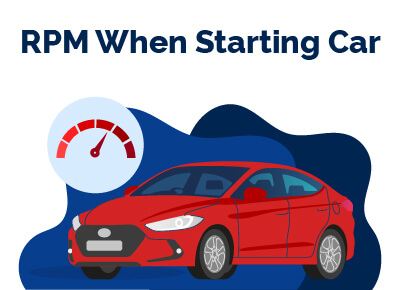What Should RPM Be When Starting a Car?
June 10, 2023


Chris is Head of Content for FindTheBestCarPrice and is based out of Philadelphia, PA. As a seasoned automotive industry analyst and car enthusiast, he ensures the highest level of quality across all our content and curates our picks for the best deals each month.
Chris studied information systems and marketing at Drexel University and writes about a wide range of topics ranging from car buying tips to troubleshooting common mechanical issues.
When he’s not thinking about cars, he likes to stay in with his dog and make an “attempt” to finish a crossword puzzle (he’s not quite at the Saturday/Sunday level…yet). As a former cheesemonger, Chris still has a “sharp” passion for all things cheese, and his fridge is always loaded with it!
Chris also has a passion for things that go fast, and drones are no exception. He spends some of his time writing for Dronesourced.
Your car's RPM remains one of the most important readings that you shouldn't ignore, especially when you're starting your car. It is important that you study your car's RPM when you are starting it and ensure that the levels are always consistent.
The position of the RPM on the dial can detect if you'll have a jumpy start, stalling engine, or a cool ride. RPM fluctuations can indicate that something is wrong with your vehicle, or it might just be your vehicle responding to weather changes.
So, what should RPM be when starting a car? The normal RPM that your car should have when you start is between 600 and 1,000 RPM. However, there are a lot of factors that can influence what RPM your vehicle will get when it starts.
Read on to learn all you need to know about what your rpm should be when starting a car and tips to maintain a consistent RPM range.
Table of Contents
What Should RPM Be When Starting a Car?
When starting a car, your engine's crankshaft will turn at a certain speed, allowing your RPM gauge to read how hard your engine is working. The impact of this phenomenon is that your RPM range will serve as a good indicator if your engine will stall or run normally.
Well, for the record, the average RPM that your engine should maintain when you're starting the car should fall between 600 to 1,000 RPM.
Sometimes, you might get the RPM running up to 1,200 RPM, only to settle at the normal RPM range after the engine warms up. That's not bad. There are quite a few factors that can influence the RPM when you're starting a car.
Let's give you a brief intro into what RPMs are and their significance in your car, and the factors that can influence what the RPM reads.
What Are RPMs?
RPMs are simply an abbreviation for revolutions per minute(s). They capture the speed and operation condition of your car's engine. This explains the number of times per minute your car's engine's crankshaft will have to make a full rotation across the number of pistons going up and down in the cylinder.
If you're observant, you should notice that your car's RPM will increase when you rev your engine or as long as your feet step on the accelerator pedal.
This is because hitting the accelerator opens up the throttle to allow more air intake, influencing more fuel pumps and ensuring more work in the engine. So, as the accelerator pedal is pressed, more work is done, the crankshaft rotates more, and the RPM increases.
But why, then, does your car's RPM increase when you're on neutral or when the car is idle?
Why Does My Car Stay at High RPM in Neutral?
One of the recurring questions is why your car's RPM won't sit at 0 when you're on neutral and you aren't pressing the gas pedals.
That's tricky. You aren't pressing the gas pedals, so why's the RPM not dropping to zero, or is something wrong with your car?
The truth is that there's nothing wrong with your car, and your engines are in good shape even though your RPM stays high when you don't have your feet on the gas pedal.
The truth is that your car RPM doesn't need to sit at 0 when you're on neutral or not pressing the gas pedal. This is because your engines are still working even though you're not pressing the gas pedals.
The only situation where your RPM will drop to zero is if your car's ignition is turned off. But as long as the ignition is on and the engine is running yet idling, a few systems will need to keep running in your car: the alternator, water pump, hydraulic pump, and lots more.
If these systems run and your engine functions, your RPM won't drop to zero.
Factors That Affect Your RPM When Starting Your Car
1. Type of Fuel
When we say that the type of fuel that your car uses influences the starting RPM, we don't imply whether you're driving with a premium or an unleaded gas. The type of fuel we mean here depends on whether you're using diesel or gasoline.
This isn't just restricted to the fuel type but also the type of engines. Diesel engines operate in compression combustion, while gasoline runs on a spark combustion system. You'll get less RPM with diesel than with gasoline.
2. Temperature and Weather Conditions
One of the major factors that influence your car's RPM when you start is the weather. In some cases, you'll notice that your RPM rises so high during cold temperatures but runs low during hot weather conditions.
This is normal. Temperature influences the state of your engine. Cold engines will burn much more fuel to heat up than when the engines are hot. The difference in RPM might rise to a considerable level, but not more than 20%.
3. Engine Size
Most drivers make the mistake of limiting discussions about engine size to its impact on the aerodynamics of a car.
These big engines are usually heavy, loud, and a bad source of air pollution, but they also influence your car's RPM. This is because the size of your engine tells a lot about its efficiency and combustion.
Engine displacement or rather configurations can decide how high or low your RPM is going to be when you're starting the car.
With a 2.0L diesel engine, you might get a car idling at around 850 RPM, unlike a 3.0L diesel engine that will return 700 RPM. This implies that the bigger the engine, the lower the RPM.
4. Type of Vehicle
Different vehicles have their RPM ranges. This also depends on whether your car is running on a diesel or a petrol engine.
It's necessary that you confirm from the manufacturer or dealer the RPM range of your car, RPM when it's idling, when it runs at a certain speed, driving at a highway, or changing to a particular gear.
The number of engine rotations peculiar to your vehicle will influence its RPM at starting.
Why Is My Car at 1,500 RPM When I Start It?
You don't need to worry whenever your car's RPM rises to 1,500 when you start it. This is normal. However, you must understand why it is so.
One of the major reasons why your car gets up to 1,500 RPM when you start it is the cold temperature. When your engine is cold, your RPM will go as high as 1,500 RPM, but it will settle after a few moments.
Why Do Cars Idle High When Started?
We've explained that cold temperature is one of the major reasons why your car idles high when started.
However, if this has been happening for a long time and you've noticed that your car's RPM idles at very high readings when started or the readings are irregular, there's a chance that something is wrong with your car.
Here are some possible reasons why the car is idling high:
- Vacuum leak
- Sticky idle control valve
- Bad spark plugs
- Faulty computer and sensors
- Faulty fuse
Conclusion
Your car's RPM can tell you a whole lot about the performance of your engine. While it's established that a good engine should put your car's RPM between 600 and 1,000 when you start it, you should also know that a few factors cause a spike in the RPM range.
Best Car Deals by Category
Frequently Asked Questions
When I start my car, why is the RPM above 1?
It's normal for your RPM to go above '1' when you start your car. By '1,’ we mean over 1,000 RPM. This can happen, especially if you're trying to run the engine in cold weather. In some other cases, there are chances that you have a bad spark plug, faulty fuse, vacuum leak, etc.
Is RPM supposed to be at 0 when parked?
It depends. Your RPM will be at 0 when parked if you turn off the ignition and your engine isn't running. If you parked your car but didn't turn off the ignition, you put the gear on 'Park' and leave the engine running, and then the RPM won't drop to 0.
What is the normal RPM on a cold start?
The normal RPM on a cold start is between 1,000 and 1,500 RPM. A cold start will get your RPMs higher than you'll get running your engine in normal conditions. This is because your engine needs to warm up, and after that is done, the RPMs will go back to normal.
Why is my car 2,000 RPM when I start it?
Your engine or car components have a problem if your car is 2,000 RPM when you start it. This might be a case of engine misfiring, a vacuum leak, or your spark plugs being bad.
2,000 RPM is very high, even for a cold engine. To verify the exact cause, you might decide to take your car to a mechanic.
What idle RPM is too high?
Idling at 2,000 RPM is too high. Normal car RPM falls within the ranges of 600 to 1,000 RPM. Consider seeing the mechanic if your RPM is running up to 2,000 RPM.
Posted in Car Buying Tips, Car Troubleshooting |




